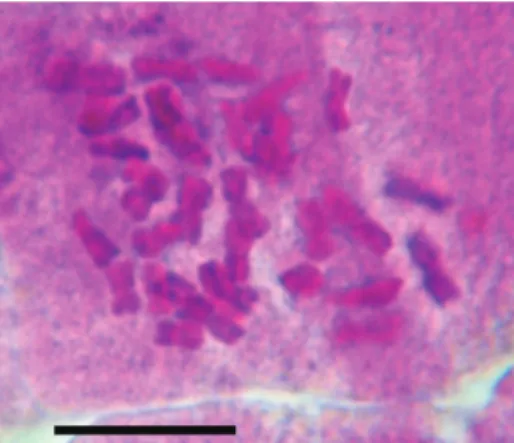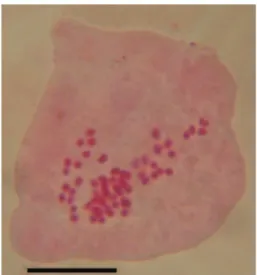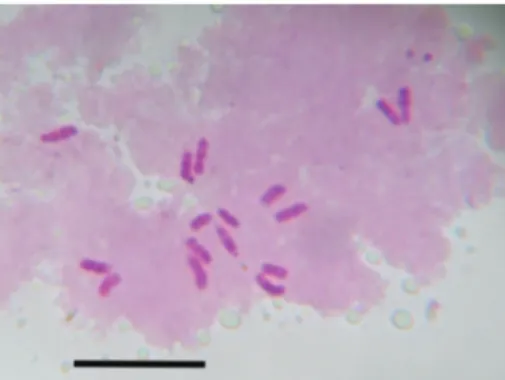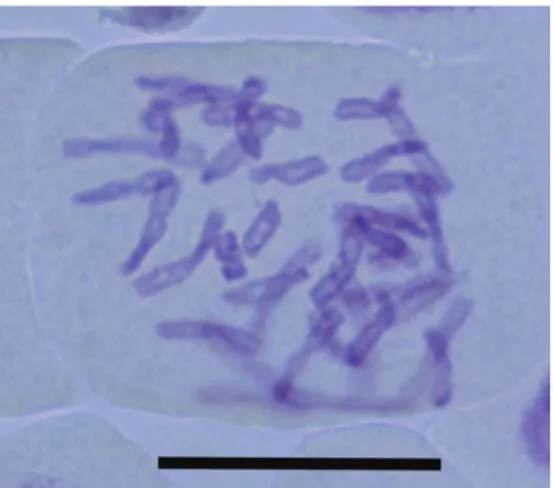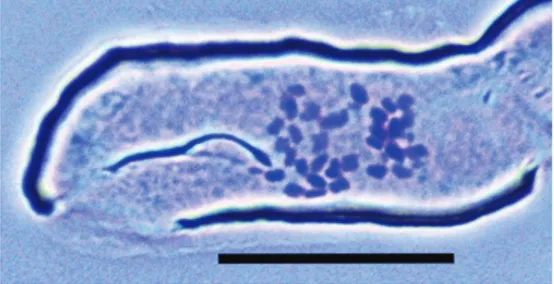1 Dipartimento di Biologia, Università di Pisa, Via Derna 1, 56126 Pisa, Italy 2 Scuola di Bioscienze e
Me-dicina Veterinaria, Università di Camerino – Centro Ricerche Floristiche dell’Appennino, Parco Nazionale del Gran Sasso e Monti della Laga, San Colombo, 67021 Barisciano (L’Aquila), Italy
Corresponding author: Lorenzo Peruzzi ([email protected])
Academic editor: G. Domina | Received 23 October 2016 | Accepted 26 October 2016 | Published 10 November 2016
Citation: Peruzzi L, Astuti G, Bartolucci F, Conti F, Roma-Marzio F (2016) Chromosome numbers for the Italian flora: 2. Italian Botanist 2: 29–42. doi: 10.3897/italianbotanist.2.10900
Abstract
In this contribution new chromosome numbers for Italian endemic taxa are presented. It includes 13 chromosome counts for Ornithogalum (Asparagaceae), Anthemis, Carduus, Centaurea, Cirsium,
Hiera-cium, Taraxacum (Asteraceae), Asyneuma (Campanulaceae), Knautia (Caprifoliaceae), Gypsophila
(Caryo-phyllaceae), Linum (Linaceae), Helleborus (Ranunculaceae).
Keywords
Cytogeography, cytotaxonomy, karyotype
How to contribute
The text concerning new chromosome data should be submitted electronically to Lorenzo Peruzzi ([email protected]), including indications on voucher speci-mens and methods used.
Copyright Lorenzo Peruzzi et al. This is an open access article distributed under the terms of the Creative Commons Attribution License (CC BY 4.0), which permits unrestricted use, distribution, and reproduction in any medium, provided the original author and source are credited.
sante meridionale (Cosenza), substrato calcareo 4 August 2011, L. Bernardo, L.
Peruz-zi, D. Gargano (CLU).
Method. Squash preparations were made on root tips obtained from germinating seeds. Root tips were pre-treated with 0.4% colchicine for 3 h and then fixed in Carnoy fixative solution for 1 h. After hydrolysis in 1N HCl at 60 °C, the tips were stained in leuco-basic fuchsin.
Observations. Linum katiae occurs only in Calabria, restricted to a single popula-tion on the Pollino Massif (Manfriana mountain) (Peruzzi 2011). The chromosome number found is consistent with all the other existing counts reported for the Italian populations belonging to species in the Linum perenne group (Bedini et al. 2010 on-wards). This species also exhibits a certain morphological affinity with L. narbonense L., in having relatively elongated styles and sepals ciliolate at the margins (Peruzzi 2011). However, the latter species shows a completely different chromosome complement, i.e., 2n = 28 (Ray 1944, Bari and Godward 1970, Löve and Kjellqvist 1974, Rogers 1980, González Zapatero et al. 1989, Yurkevich et al. 2009, Muravenko et al. 2010), so that any close relationship between L. katiae and L. narbonense can be excluded, according to our results.
Hieracium portanum Belli (Asteraceae) Chromosome number: 2n = 36 (Fig. 2)
Voucher specimen. ITALY. Calabria. Tra la Manfriana e Timpa del Principe, ver-sante meridionale (Cosenza), substrato calcareo 4 August 2011, L. Bernardo, L.
Peruz-zi, D. Gargano (CLU).
Method. Squash preparations were made on root tips obtained from germinating seeds. Root tips were pre-treated with 0.4% colchicine for 3 h and then fixed in Carnoy fixative solution for 1 h. After hydrolysis in 1N HCl at 60 °C, the tips were stained in leuco-basic fuchsin.
Observations. This species is endemic to Basilicata and Calabria (Peruzzi et al. 2014), and it is typical of calcareous cliffs on the Pollino Massif. According to our re-sults, H. portanum is tetraploid with 2n = 4x = 36, since the base chromosome number of this genus is x = 9 (Ilnicki and Szeląg 2011).
Figure 1. Linum katiae Peruzzi, 2n = 18. Scale bar: 10 µm.
Figure 2. Hieracium portanum Belli, 2n = 36. Scale bar: 10 µm.
Asyneuma trichocalycinum (Ten.) K.Malý (Campanulaceae) Chromosome number: 2n = 64 (Fig. 3)
Voucher specimen. ITALY. Basilicata. Fontana di Rummo, Massiccio del Pollino (Viggianello, Potenza), 13 August 2011, L. Peruzzi (seeds collected in the field).
Method. Squash preparations were made on root tips obtained from germinating seeds. Root tips were pre-treated with 0.4% colchicine for 3 h and then fixed in Carnoy fixative solution for 1 h. After hydrolysis in 1N HCl at 60 °C, the tips were stained in leuco-basic fuchsin.
Observations. This species is restricted to southern Italy, where it occurs in Cam-pania, Basilicata, and Calabria, whereas its presence is not confirmed in Abruzzo and Sicily (Peruzzi et al. 2014). In the past, at least three chromosome counts were at-tributed to A. trichocalycinum (Contandriopoulos 1966, Tzanoudakis and Kypriota-kis 1987, Anchev 1993), but according to their geographical provenance they should all be referred to A. pichleri (Vis.) D.Lakušić & F.Conti (Lakušić and Conti 2004).
Therefore, chromosome number also distinguishes these two species, since Asyneuma
trichocalycinum is possibly tetraploid with 2n = 4x = 64 chromosomes, while the closely
related A. pichleri from the Balkans is diploid with 2n = 2x = 32.
Carduus nutans L. subsp. perspinosus (Fiori) Arènes (Asteraceae) Chromosome number: 2n = 16 (Fig. 4)
Voucher specimen. ITALY. Calabria. Montea-Caramolo mountain range, Serra Paratizzi (San Donato di Ninea, Cosenza), 17 August 2014, L. Peruzzi (seeds collected in the field).
Method. Squash preparations were made on root tips obtained from germinating seeds. Root tips were pre-treated with 0.4% colchicine for 3 h and then fixed in Carnoy fixative solution for 1 h. After hydrolysis in 1N HCl at 60 °C, the tips were stained in leuco-basic fuchsin.
Observations. This taxon is distributed in central-southern Italy, from Emilia-Romagna to Calabria (Peruzzi et al. 2014). Like the autonymic subspecies, it has 2n = 2x = 16 chromosomes, the only chromosome number found until now within this species (Bedini et al. 2010 onwards).
Gypsophila arrostii Guss. subsp. arrostii (Caryophyllaceae) Chromosome number: 2n = 34 (Fig. 5)
Voucher specimen. ITALY. Calabria. loc. La Cona (Tarsia, Cosenza), 15 August 2014, L. Peruzzi (PI).
Method. Squash preparations were made on root tips obtained from germinating seeds. Root tips were pre-treated with 0.4% colchicine for 3 h and then fixed in Carnoy fixative solution for 1 h. After hydrolysis in 1N HCl at 60 °C, the tips were stained in leuco-basic fuchsin.
Observations. This subspecies is endemic to southern Italy (Apulia, Basilicata, Calabria, and Sicily; Peruzzi et al. 2014), whereas the species is distributed also in Turkey with G. arrostii Guss. subsp. nebulosa (Boiss. & Heldr.) Greuter & Burdet (Marhold 2011). Another count was already reported for G. arrostii s.l. (Blackburn in Tischler 1931; 2n = 68), but the origin of the sampled plants (possibly tetraploid) is unknown. Therefore, our count represents the first certain chromosome number report for G. arrostii subsp. arrostii and it confirms the base chromosome number x = 17, which seems typical of the genus (Rice et al. 2014).
Knautia dinarica (Murb.) Borbás subsp. silana (Grande) Ehrend. (Caprifoliaceae) Chromosome number: 2n = 40 (Fig. 6)
Voucher specimen. ITALY. Basilicata. Piano Ruggio, Pollino Massif (Viggianello, Potenza), 6 August 2014, L. Peruzzi (seeds collected in the field).
Figure 4. Carduus nutans L. subsp. perspinosus (Fiori) Arènes, 2n = 16. Scale bar: 10 μm.
Method. Squash preparations were made on root tips obtained from germinating seeds. Root tips were pre-treated with 0.4% colchicine for 3 h and then fixed in Carnoy fixative solution for 1 h. After hydrolysis in 1N HCl at 60 °C, the tips were stained in leuco-basic fuchsin.
Observations. This taxon is restricted to Italy, where it occurs on the mountains of the Majella (Abruzzo), Pollino Massif (Basilicata) and Sila (Calabria) (Peruzzi et al. 2013). Two other counts are known for this taxon, one for Abruzzo (2n = 20; see Peruzzi et al. 2013) and one for Calabria (2n = 40; see Ehrendorfer 1975), the latter corresponding to the same chromosome number found by us and showing a tetra-ploid asset. Our finding further supports the conclusions by Peruzzi et al. (2013), who consider diploids and tetraploids as belonging to the same taxon. Indeed, the studied tetraploid plants are morphologically more similar to the diploids growing in Abruzzo than to tetraploids in the Sila (Calabria).
Ornithogalum etruscum Parl. subsp. etruscum (Asparagaceae) Chromosome number: 2n = 36 (Fig. 7)
Voucher specimen. ITALY. Basilicata. Mt. Pierno, Irpinia (San Fele, Potenza), faggete, boschi di latifoglie, pascoli e rupi calcaree (WGS84 33T 551245 E, 4515202 N), 1075–1268 m s.l.m., 5 June 2015, G. Astuti, L. Peruzzi, F. Roma-Marzio (PI).
Method. Squash preparations were made on root tips obtained from germinating seeds. Root tips were pre-treated with 0.4% colchicine for 3 h and then fixed in Carnoy fixative solution for 1 h. After hydrolysis in 1N HCl at 60 °C, the tips were stained in leuco-basic fuchsin.
Observations. Ornithogalum etruscum is distributed in northern and central Italy, with two subspecies: O. etruscum subsp. etruscum (in Liguria, Tuscany, Marche Um-Figure 6. Knautia dinarica (Murb.) Borbás subsp. silana (Grande) Ehrend., 2n = 40. Scale bar: 10 μm.
bria, Latium, Abruzzo, Molise and Apulia) and O. etruscum subsp. umbratile (Tornad. & Garbari) Peruzzi & Bartolucci (in Emilia-Romagna, Tuscany, Marche, Umbria, La-tium, and Apulia) (Peruzzi et al. 2014). The autonymic subspecies has been reported as triploid (2n = 3x = 27), tetraploid (2n = 4x = 36), hexaploid (2n = 6x = 54), octoploid (2n = 8x = 72) and decaploid (2n = 10x = 90) (see Tornadore et al. 2003, Peruzzi and Bartolucci 2008), whereas the latter as hexaploid, heptaploid, and octoploid (see Tor-nadore et al. 2003, Peruzzi and Bartolucci 2008, Scassellati and Bartolucci 2009). The source of the count with 2n = 36, reported by Tornadore et al. (2003) for O. etruscum subsp. etruscum, is unknown. Thus, our 2n = 36 count is the first documented for
O. etruscum subsp. etruscum, and it was obtained from material representing the first
record of this taxon in Basilicata (A. Stinca and collaborators, in preparation). The morphological features of the studied plants are very similar to those of the diploid
Ornithogalum orthophyllum Ten., a further Italian endemic (Peruzzi et al. 2014). A
careful biosystematic revision of these two taxa, involving several accessions all across their ranges, would be desirable. In addition, both names still lack typification (Peruzzi et al. 2015).
Taraxacum gianninii Arrigoni, Ferretti & Padula (Asteraceae) Chromosome number: 2n = 24 (Fig. 8)
Voucher specimen. ITALY. Tuscany. Pratofiorito (Bagni di Lucca, Lucca), sentie-ro a margine di bosco, 1117 m s.l.m., 20 May 2015, F. Roma-Marzio, M. D’Antraccoli,
G. Astuti, L. Peruzzi (PI).
Method. Squash preparations were made on root tips obtained from germinating seeds. Root tips were pre-treated with 0.4% colchicine for 3 h and then fixed in Carnoy fixative solution for 1 h. After hydrolysis in 1N HCl at 60 °C, the tips were stained in leuco-basic fuchsin.
Observations. This species occurs only in Tuscany on the Appennino Lucchese (Arri-goni 2006). According to Kirschner et al. (2007 onwards), this taxon is included within T. sect. Taraxacum, which mostly includes diploid and triploid taxa (Richards 1969, Mogie and Richards 1983). Based on our results, T. gianninii is triploid, i.e., 2n = 3x = 24.
Figure 8. Taraxacum gianninii Arrigoni, Ferretti & Padula, 2n = 24. Scale bar: 10 μm.
Figure 9. Taraxacum lucense Arrigoni, Ferretti & Padula, 2n = 24. Scale bar: 10 μm.
Taraxacum lucense Arrigoni, Ferretti & Padula (Asteraceae) Chromosome number: 2n = 24 (Fig. 9)
Voucher specimen. ITALY. Tuscany. Pratofiorito (Bagni di Lucca, Lucca), sentie-ro a margine di bosco, 1117 m s.l.m., 20 May 2015, F. Roma-Marzio, M. D’Antraccoli,
G. Astuti, L. Peruzzi (PI).
Method. Squash preparations were made on root tips obtained from germinating seeds. Root tips were pre-treated with 0.4% colchicine for 3 h and then fixed in Carnoy fixative solution for 1 h. After hydrolysis in 1N HCl at 60 °C, the tips were stained in leuco-basic fuchsin.
Observations. Similar to Taraxacum gianninii, T. lucense is distributed on the Ap-pennino Lucchese, and sometimes these two species share the same sites (Arrigoni 2006). According to our count, T. lucense is also triploid with 2n = 3x = 24, the most common chromosome number found in T. sect. Erythrosperma (Richards 1969) to which T. lucense belongs.
Figure 10. Anthemis cretica L. subsp. petraea (Ten.) Oberpr. & Greuter, 2n = 36. Scale bar: 10 μm.
Anthemis cretica L. subsp. petraea (Ten.) Oberpr. & Greuter (Asteraceae) Chromosome number: 2n = 36 (Fig. 10)
Voucher specimen. ITALY. Abruzzo. Feudo d’Ugni, Majella (Pennapiedimonte, Chieti), August 2011, F. Conti, F. Bartolucci (plants cultivated under acc. n. 509/11).
Method. Squash preparations were made on root tips obtained from potted plants, originally growing in nature, cultivated at the botanical garden of Centro Ricerche Flo-ristiche dell’Appennino. Root tips were pre-treated with 0.4% colchicine for 3 h and then fixed in Carnoy fixative solution for 1 h. After hydrolysis in 1N HCl at 60 °C, the tips were stained in leuco-basic fuchsin.
Observations. This taxon occurs exclusively in the Abruzzo administrative region (Peruzzi et al. 2014), where it is distributed on the Majella and Morrone mountains as well as on Pizzo Intermesoli and Corno Piccolo (Gran Sasso) (Conti 1998, Conti and Bartolucci 2016). This is the first chromosome count ever for this taxon, which dif-fers from the nominal subspecies by having 2n = 36 instead of 2n = 18 chromosomes (Brullo and Pavone 1978). Hence, similar to five other subspecies of A. cretica occurring in Italy, A. cretica subsp. calabrica (Arcang.) R.Fern., A. cretica subsp. carpatica (Willd.) Grierson, A. cretica subsp. columnae (Ten.) Franzén, A. cretica subsp. messanensis (Brul-lo) Giardina & Raimondo, and A. cretica subsp. saxatilis (DC.) R.Fern. (Capineri 1968, Brullo et al. 1988; Selvi 2009), this taxon is probably tetraploid. This probably could be the reason for its larger size as compared to A. cretica subsp. cretica (Pignatti 1982).
Centaurea ambigua Guss. subsp. ambigua (Asteraceae) Chromosome number: 2n = 36 (Fig. 11)
Voucher specimen. ITALY. Abruzzo. Guado S. Antonio, Majella (Caramanico Terme, Pescara), August 2006, G. D’Orazio (plants cultivated under acc. n. 248/06).
Method. Squash preparations were made on root tips obtained from potted plants, originally growing in nature, cultivated at the botanical garden of Centro Ricerche Flo-ristiche dell’Appennino. Root tips were pre-treated with 0.4% colchicine for 3 h and then fixed in Carnoy fixative solution for 1 h. After hydrolysis in 1N HCl at 60 °C, the tips were stained in leuco-basic fuchsin.
Observations. Centaurea ambigua is endemic to Italy, distributed in central-south-ern zones, from Emilia-Romagna to Calabria, but doubtfully occurring in Campania. The autonymic subspecies occurs in these same regions, except Tuscany (Peruzzi et al 2014). The only other existing chromosome count for C. ambigua pertains to C.
ambi-gua subsp. nigra (Fiori) Pignatti, which shows 2n = 2x = 18 chromosomes (Baltisberger
1991), different from C. ambigua subsp. ambigua. Hence, C. ambigua subsp. ambigua probably represents a tetraploid unit.
Cirsium lobelii Ten. (Asteraceae)
Chromosome number: 2n = 34 (Fig. 12)
Voucher specimen. ITALY. Abruzzo. Near Lago Racollo (Santo Stefano di Sessanio, L’Aquila), July 2011, F. Bartolucci, N. Ranalli (plants cultivated under acc. n. 492/11). Figure 11. Centaurea ambigua Guss. subsp. ambigua, 2n = 36. Scale bar: 10 μm.
Method. Squash preparations were made on root tips obtained from potted plants, originally growing in nature, cultivated at the botanical garden of Centro Ricerche Flo-ristiche dell’Appennino. Root tips were pre-treated with 0.4% colchicine for 3 h and then fixed in Carnoy fixative solution for 1 h. After hydrolysis in 1N HCl at 60 °C, the tips were stained in leuco-basic fuchsin.
Observations. This species is distributed in central and southern Italy (Peruzzi et al. 2014). According to our count, 2n = 34 it shares the same chromosome number of all the other karyologically studied species within the C. eriophorum (L.) Scop. group, i.e., C. eriophorum s.str., C. ferox (L.) DC., and C. vallis-demonis Lojac. (Rice et al. 2014).
Helleborus viridis L. subsp. abruzzicus (M.Thomsen, McLewin & B.Mathew) Bartolucci,
F.Conti & Peruzzi (Ranunculaceae)
Chromosome number: 2n = 32 (Fig. 13)
Voucher specimen. ITALY. Abruzzo. Limite inferiore del Bosco di Fonte Novello (Fano Adriano, Teramo), 20 April 2010, F. Bartolucci, F. Conti (APP, n. 43338; plants cultivated under acc. n. 522/11).
Method. Squash preparations were made on root tips obtained from potted plants, originally growing in nature, cultivated at the botanical garden of Centro Ricerche Flo-ristiche dell’Appennino. Root tips were pre-treated with 0.4% colchicine for 3 h and then fixed in Carnoy fixative solution for 1 h. After hydrolysis in 1N HCl at 60 °C, the tips were stained in leuco-basic fuchsin.
Observations. This subspecies is endemic to central (Umbria, Latium, and Abru-zzo, doubtful in Marche) and southern Italy (Peruzzi et al. 2014). The chromosome number shown is the same found in H. viridis L. subsp. viridis, as well as in most other
Helleborus species (Rice et al. 2014).
Botanico Italiano 22: 216–226.
Bari G, Gordward MBE (1970) Interspecific crosses in Linum. Euphytica 19: 443–446. doi: 10.1007/BF01902918
Bedini G, Garbari F, Peruzzi L (2010 onwards) Chrobase.it. Chromosome numbers for the Ital-ian flora. Available from: www.biologia.unipi.it/chrobase [accessed 16 July 2016]
Brullo S, Pavone P (1978) Numeri Cromosomici per la Flora Italiana: 464–483. Informatore Botanico Italiano 10: 248–264.
Brullo S, Pavone P, Terrasi MC (1988) Osservazioni citotassonomiche sulle popolazioni tetraploidi di Anthemis della Sicilia e Italia meridionale. Giornale Botanico Italiano 122(suppl. 1): 50. Capineri R (1968) Cariologia di alcune specie di Anthemis. Giornale Botanico Italiano 102(6): 548. Contandriopoulos J (1966) Contribution à l’étude cytotaxinomique des Campanula-cées de Grèce II. Bulletin de la Société Botanique de France 113: 453–474. doi: 10.1080/00378941.1966.10835555
Conti F (1998) An annotated checklist of the Flora of the Abruzzo. Bocconea 10: 1–273. Conti F, Bartolucci F (2016) The vascular flora of Gran Sasso and Monti della Laga National
Park (Central Italy). Phytotaxa 256(1): 1–119. doi: 10.11646/phytotaxa.256.1.1
Ehrendorfer F (1975) Taxonomic notes on Knautia L. In: Heywood HV (Ed.) Flora Europaea Notulae Systematicae ad Floram Europaeam spectantes 17. Botanical Journal of the Lin-nean Society 71: 39–41. doi: 10.1111/j.1095-8339.1975.tb00937.x
González Zapatero MA, Elena-Roselló JA, Andrés FN (1989) Números cromosomáticos de plantas occidentales, 527–532. Anales del Jardín Botánico de Madrid 45: 505–508. Ilnicki T, Szeląg Z (2011) Chromosome numbers in Hieracium and Pilosella (Asteraceae) in
Central and Southeastern Europe. Acta Biologica Cracoviensia Series Botanica 53(1): 102– 110. doi: 10.2478/v10182-011-0014-3
Kirschner J, Štepánek J, Greuter W (2007 onwards) Taraxacum. In: Greuter W, von Raab-Straube E (Eds) Compositae. Euro+Med Plantbase - the information resource for Eu-ro-Mediterranean plant diversity. http://ww2.bgbm.org/EuroPlusMed/PTaxonDetail. asp?NameCache=Taraxacum%20gianni nii&PTRefFk=7700000
Lakušić D, Conti F (2004) Asyneuma pichleri (Campanulaceae) a neglected species of the Bal-kan Peninsula. Plant Systematics and Evolution 247(1): 23–36. doi: 10.1007/s00606-004-0136-0
Löve A, Kjellqvist E (1974) Cytotaxonomy of Spanish plants. IV. Dicotyledons: Caesalpinaceae Asteraceae. Lagascalia 4(2): 153–211.
Marhold K (2011) Gypsophila arrostii. In: Greuter W, von Raab-Straube E (Eds) Caryophyl-laceae. Euro+Med Plantbase - the information resource for Euro-Mediterranean plant
di-Peruzzi L (2011) A new species of Linum perenne group (Linaceae) from Calabria (S Italy). Plant Biosystems 145(4): 938–944. doi: 10.1080/11263504.2011.589163
Peruzzi L, Bartolucci F, Astuti G, Bernardo L, Conti F (2013) Knautia dinarica (Caprifoliaceae): taxonomy, typification and update of the Italian distribution. Phytotaxa 116: 34–40. doi: 10.11646/phytotaxa.116.1.3
Peruzzi L, Conti F, Bartolucci F (2014) An inventory of vascular plants endemic to Italy. Phytotaxa 168: 1–75. doi: 10.11646/phytotaxa.168.1.1
Peruzzi L, Domina G, Bartolucci F, Galasso G, Peccenini S, Raimondo FM, Albano A, Ales-sandrini A, Banfi E, Barberis G, Bernardo L, Bovio M, Brullo S, Brundu G, Brunu A, Camarda I, Carta L, Conti F, Croce A, Iamonico D, Iberite M, Iiriti G, Longo D, Marsili S, Medagli P, Pistarino A, Salmeri C, Santangelo A, Scassellati E, Selvi F, Soldano A, Stinca A, Villani M, Wagensommer RP, Passalacqua NG (2015) An inventory of the names of vascular plants endemic to Italy, their loci classici and types. Phytotaxa 196(1): 1–217. doi: 10.11646/phytotaxa.196.1.1
Pignatti S (1982) Anthemis L. In: Pignatti S (Ed.) Flora d’Italia 3, Ed. Agricole, Bologna, 66–75.
Ray C (1944) Cytological studies on the flax genus Linum. American Journal of Botany 27: 241–248. doi: 10.2307/2437613
Rice A, Glick L, Abadi S, Einhorn M, Kopelman NM, Salman-Minkov A, Mayzel J, Chay O, Mayrose I (2014) The Chromosome Counts Database (CCDB) a community resource of plant chromosome numbers. http://ccdb.tau.ac.il/home/ [accessed 21 July 2016]
Rogers CM (1980) Reports. In: Löve A (Ed.) IOPB chromosome number reports LXVII. Taxon 29: 347.
Richards AJ (1969) The biosystematics of Taraxacum. Durham theses, Durham University. Available from Durham E-Theses Online: http://etheses.dur.ac.uk/1368/
Scassellati E, Bartolucci F (2009) Notula 1542. In: Nepi C, Peruzzi L, Scoppola A (Eds) Notu-lae alla checklist della flora vascolare italiana 7. Informatore Botanico Italiano 41(1): 132. Selvi F (2009) New findings of Anthemis cretica (Asteraceae) on serpentine outcrops of Tuscany
(C Italy). Flora Mediterranea 19: 119–128.
Thiers B (2016) Index Herbariorum: A global directory of public herbaria and associated 602 staff. Available from: http://sweetgum.nybg.org/ih/ [accessed 30 September 2016] Tischler G (1931) Pflanzliche Chromosomen-Zahlen (Nachtrag 1). Tabulae Biologicae
